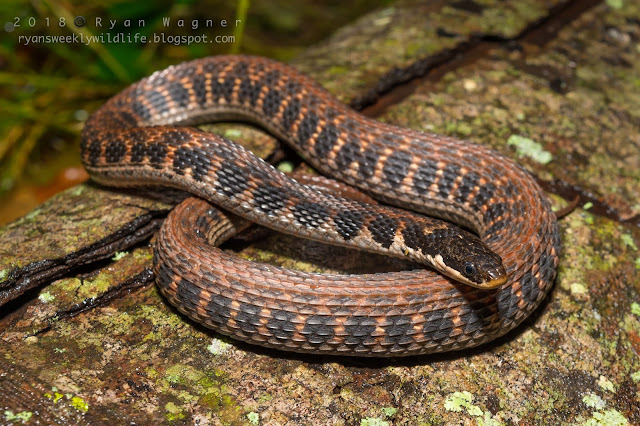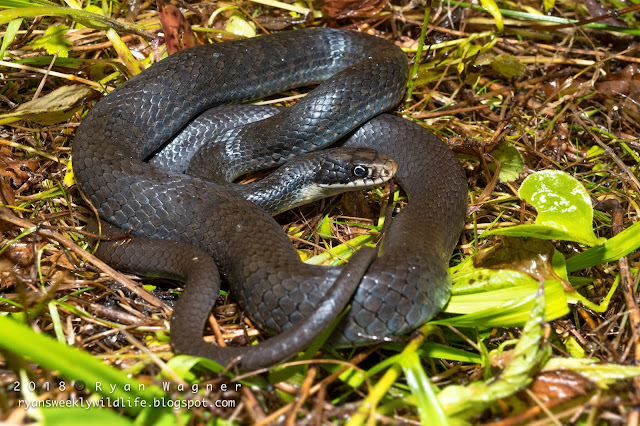The flooded vegetation sloshed underfoot, threatening to flood my muck boots with each step. After driving two hours through a torrential downpour, a break in the weather had my snake senses tingling. We were slogging through one of the more unusual of midwestern Ohio’s habitats, a wet meadow. Every few feet, my friend Daniel Moniz—The Herpetographer—paused to flip pieces of rusty roofing tin, now submerged under several centimeters of water. Tall grass and small trees obscured my view of the boards until we were right on top of them. After two days of near constant rain, the wet meadow held true to its name. We were actually concerned that the boards would be too wet, driving Ohio’s most terrestrial water snake to occupy alternative shelter.
Daniel was conducting a survey for Kirtland’s snakes (Clonophis kirtlandii)—part of a team effort across western Ohio to determine the species' current status. Kirtland’s snakes are seen so infrequently that its difficult to know where they still occur in Ohio. Having disappeared from many previously occupied counties, Kirtland’s snakes can still be found in a few scattered localities across the western half of the state. As an already threatened species, we were sure to have all our permits in order.
As we flipped one of the larger pieces of corrugated metal, the tail end of a little snake protruded from the only patch of dry vegetation. “That’s a Kirtland’s,” Daniel exclaimed. I plucked the snake from the grass, breathing a sigh of awe and relief. As we brought the snake into the light, however, we immediately realized our mistake. The snake was speckled with a row of parallel spots, not large, black blotches. This little snake was a Dekay’s or brown snake (Storeria dekayi). An interesting, if not uncommon find. We returned the snake to its shelter, and moved on to the next board.
This time, we hit pay dirt. Nearly the same size and shape as the Dekay’s, the juvenile Kirtland’s snake sat coiled near a crayfish burrow. Daniel picked the snake up before it could disappear back underground. Kirtland’s snakes require crayfish burrows in which to spend the winter and the hottest, driest days of summer. They are a relatively sedentary snake, moving only short distances from their personal crayfish getaway.
The juvenile Kirtland’s was in mid-shed with blue eye caps and dulled colors, but I could still tell what an attractive species it was. Its pattern consisted of a series of large, black blotches, running the length of a red-brown and cream-colored back. Flip a Kirtland’s snake over, and you will reveal one of the most surprising and stunning bellies of any snake species—bright red ventral scales bordered by a series of black spots.
The Kirtland’s snake is named for Dr. Jared Potter Kirtland, an 18th century physician and Ohio born naturalist from Lakewood. Birders may know him for the warbler species that also carries his namesake (Setophaga kirtlandii). Kirtland’s snakes are found only in Ohio, Michigan, Kentucky, Illinois, and Indiana, and are considered rare and declining across their entire range. They still maintain local strongholds, and have even been able to eke out a living in some urban and residential areas.
As we began our search for an adult Kirtland’s, we happened upon another snake species I had only heard about in legends. This black racer wasn't black—it was gun metal gray—likely an intergrade between the black and the blue subspecies (Coluber constrictor subspp). I couldn’t believe our good luck. The black subspecies in the east is separated from the blue in the west by a blurry band of hybrids and intergrades of varying shades. As I attempted to pose the little racer for photographs, it gave me one smart bite on the thumb before disappearing back into the tall grass.
As we began our search for an adult Kirtland’s, we happened upon another snake species I had only heard about in legends. This black racer wasn't black—it was gun metal gray—likely an intergrade between the black and the blue subspecies (Coluber constrictor subspp). I couldn’t believe our good luck. The black subspecies in the east is separated from the blue in the west by a blurry band of hybrids and intergrades of varying shades. As I attempted to pose the little racer for photographs, it gave me one smart bite on the thumb before disappearing back into the tall grass.
With two rare Ohio snakes under our belts, we had our minds on another species. The eastern Massasuaga rattlesnake (Sistrurus catenatus) could occur here as well. Having lived in Michigan for several years, Daniel knows what and where to look for this endangered pygmy rattlesnake. If anyone can find them here, it’s him. With the help of old locality records, Daniel has also been hot on the trail of the spotted turtle (Clemmys guttata), another threatened species in Ohio. The state’s rarest herpetofauna may still be at home in the wet fields and meadows of western Ohio.
The following boards we flipped seemed impossibly waterlogged. They practically floated on top of several inches of inundated vegetation. I was astonished to find a large, likely gravid, female Kirtland’s snake hanging suspended in the water under one of the sheets of tin. The rain and rising water level hadn't frightened her away. In fact, Daniel thought he recognized the snake from a previous trip—and it was under the very same board.
This Kirtland’s snake was an impressive specimen, about the length of your average eastern garter, slightly chunkier, and with heavily keeled scales. Her detailed pattern and colors were astonishingly vivid—that belly is no joke. Kirtland’s snakes occasionally mock strike, but never bite when handled. Daniel pointed out this species' bizarre, exaggerated breathing as the little snake sat placidly in my hand. Her ribs visibly expanded and contracted as if she were trying to pump out a sound. We released the handsome snake back under the tin, beyond satisfied with the scaly encounter.
Threats to Kirtland’s snakes still persist across their range. Much of their habitat has already been lost to agriculture and development and succession of forests continue to reduce natural meadow habitat. The use of pesticides and other chemicals threaten to damage the crayfish burrow micro biomes which these, and others snakes, depend upon for shelter. Road mortality, controlled burns, construction, and illegal collection for the pet trade have all taken their toll. Where they still are found, Kirtland’s snakes are an essential link to a more pristine and wild Ohio.
 I thanked Daniel for the excellent trip, hoping to meet back up with him in the field soon. I left for home, brain swimming with kirtland's snakes, spotted turtles, and imaginary massasaugas, nothing but rainy oblivion on the darkening horizon, and two hours home. . .
I thanked Daniel for the excellent trip, hoping to meet back up with him in the field soon. I left for home, brain swimming with kirtland's snakes, spotted turtles, and imaginary massasaugas, nothing but rainy oblivion on the darkening horizon, and two hours home. . .
 I thanked Daniel for the excellent trip, hoping to meet back up with him in the field soon. I left for home, brain swimming with kirtland's snakes, spotted turtles, and imaginary massasaugas, nothing but rainy oblivion on the darkening horizon, and two hours home. . .
I thanked Daniel for the excellent trip, hoping to meet back up with him in the field soon. I left for home, brain swimming with kirtland's snakes, spotted turtles, and imaginary massasaugas, nothing but rainy oblivion on the darkening horizon, and two hours home. . .










No comments:
Post a Comment